#kuiper core
Explore tagged Tumblr posts
Text

I have always loved this final(ish) boss design in Wild Arms 2nd Ignition so I'm just gonna babble for a bit here, apropos of nothing. So, spoilers I guess(?) for a quarter of a century year old game --I think it's still available on the PlaystationStore, but obviously emus are always an option. Large flightless Australian birds are crafty like that.
Even though, design-wise, a good chunk of it falls in line with pretty standard JRPG angelic monster/grotesque angel/now-your-teen-hero-fights-god motifs, it was just so out there in terms of lore.
The game starts with you gathering a band of heroes --A fresh faced army recruit, a grizzled war hero, a magical girl, a sacrificial martyr, a brooding anti-hero, and an optional vampire-- to fight an evil organization out to take over the world.
The evil organization, Odessa, declares that the world is changing, monsters are popping everywhere, and the kingdoms of the world do nothing about it, and so they threaten that if kings and queens and politicians cannot or will not do anything about it, then Odessa will conquer their kingdoms, seize their resources and manpower, and they will fix the problem thru unilateral authority.
But while there is a certain righteous anger behind their manifesto, they of course end up attacking innocent civilians, staffing themselves with war criminals and homicidal lunatics, sacrificing people to summon demons, using the monsters they claim to want gone as weapons, and ultimately trying to threaten the world's governments into submission with a nuke that is also a dragon...
So you smack their four generals around, corner their boss in his giant flying fortress, and then when he knows he's done for he tries to launch himself and the heroes into space to kill them all. It mostly fails, in so much as your party escapes the fortress, but the protagonist stays behind like the big damn hero that he is and consequently dies in space... He gets better tho, don't worry.


But then comes the sort of inverted 3rd act twist --instead of all hope being lost and then a reveal saves the day, everything seems like we should be done with the world ending threats and the world should be safe, until it's revealed that it is very much not-- an alternate universe is colliding with this one, and has been the whole time...
What that really means and how that works and how to envision that is left meaningfully abstract. Metaphorically the other world threatens to "devour" theirs, but it's not clear what that consumption even means... The slowly merging realities are actually why those monsters Odessa swore to eradicate had been appearing at all, and as the two alternate realities collide, the shape of the extra dimensional invasion isn't just a flood of monsters, but that the very nature of reality in this other world will come to replace this one.
Also in a cool throw back to the original Wild Arms, in which the extraterrestrial demon invasion the kicks off the game's plot is heralded by the sky cracking and chipping away, when the protag recovers from his whole died-in-space situation, he awakens to a literally unfamiliar, alien sky... a shifting, sloshing, iridescent acid trip looming over a doomed planet.



In fact the terrorist threat that had consumed so much of the heroes efforts until now was part of an elaborate long con by a certain wealthy would-be-hero out to save the world from the existential threat of total annihilation... The same man who recruited your heroes to fight terrorist in the first place.
Convinced that the world governments would be too fickle and petty to set aside their differences and personal interests to combat something as incomprehensible as (another)reality itself, he actually funded the terrorist organization in order to scare the world into cooperation against something much more concrete and straight forward --or, if international cooperation really did prove impossible, then as an owner of the new dictatorial world government, he'd simply make Odessa to save the world for him.
(A Note: The whole thing has strong american cape comic energy running thru it, specifically Watchmen and DC's Crisis on Infinite Earths.)
But then even his Xanatos gambit falls just short of saving the world in the final stages, and he's pushed into a corner. It turns out that even after tricking the nations of the world into allowing him access to harnessing the raw life force of the planet itself, the life force of a planet with a dying ecosystem just isn't enough to contain this hungry eldritch reality. So, in a last ditch effort he turns to the raw energy of creation, the miracle of life itself, to contain the menace and shackle it to a tangible reality in which it can be fought and killed... and so in a prison of otherworldly flesh contained in the belly of the earth itself, you confront the alternate universe in the form of an unborn child, and with his mind speaking thru it he tells you to kill him.
Anyway, yeah, that's you end up in a big red meat room fighting a vaguely angelic baby in an orb.



Immediately the thing that jumps out is, "Hey, that's the Starchild from 2001: A Space Odyssey!" Which is of course, very cool because everyone loves an unnerving weird fetus. But when it comes to JRPGS and weird fetuses, and incomprehensible reality destroying menaces, of course, the first thing to come to mind is Gigyas in Earthbound.
But more over, I really love that --where as, by point of comparison, there have been questionable theories about the layout of the Devil's Machine dungeon map looking like a womb, piggybacking off Giygas's ultrasound looking fetus shadow pattern-- the rest of the boss form surrounding the little Starchild core actually do appear to be modeled off a reproductive system, complete with ovaries and fallopian tubes, even going so far as to include the fimbriae as stylized angelic wings.


And I like the odd little detail that, because most babies develop upside down, the design with the fetus upright seems to have taken that into account by also rotating the reproductive anatomy accordingly? The baby is upright, so the organs are upside down.
Plus, even though it's not how fallopian tubes look in a real body, most anatomical diagram will show them as having this kind of flared arc over and around the ovaries beneath them, but the wings of the Kupier core arc under the two green orbs approximating ovaries. All that just to say that the big metal golden halo structure hanging under the core is technically oriented toward the "top" of the implied anatomy.
Also the game has a whole big subplot about a Christlike martyr --as an extension of the broader themes of heroism, and what it really means to be a hero-- and there is even a moment just before this final dungeon where Irving refers to his sister, the mother carrying this alternate reality made flesh, as "The Madonna of Destruction"... That all being context to support that, although it can be hard to notice or discern meaningful details on, that weird little fetus is definitely wearing what I can only assume is a crown of thorns.(I mean, that or it could be a pair of little devil horns? but I find that a less interesting alternative) Because he was, after all, conceived(although not so immaculately...) so that he could die to save the world.


Also not at all related to any fun themes or anything but I like how there's this big mouth it's seated in, that I only just realized has a "bottom" jaw to it. The top teeth are most noticeable and go around the front and sides, and I always kinda assumed they were a nod to the whole vagina dentata myth, but on a scale and at an angle that would've been imperceptible thru the blur of a CRT, there's definitely 4 little teeth normally hidden by the glare of the little uterus bubble
Oh and I didn't even get into the name itself being named after the Kuiper Belt, the asteroid belt around our real world solarsystem, as a play into some other astronomical terminology the story borrows from; namely the event horizon of a blackhole being referred to as the thing sealing away the mythic evil demon that started the whole world decay thing that makes the setting a desert wasteland in the first place, and became the wrench in the aforementioned plan to harness the planet's life force as a weapon against the parallel universe.(that ancient evil demon is the actual/surprise final boss of the game after this fight, btw...) There's so much more going on just in general, but that doesn't really play into the way this boss mosnters looks or why.
11 notes
·
View notes
Text




#wild arms#wild arms 2#wild arms bestiary#monster card album#first root#second root#third root#kuiper core
8 notes
·
View notes
Text
@fresh-depression-soup
well what if i want to bite the hand that feeds me but fondly. gently. what then
28K notes
·
View notes
Link
SpaceTime Series 27 Episode 123 *Discovery of a New Region within the Earth's Core Scientists have uncovered a doughnut-shaped region within Earth's molten liquid outer core, located at low latitudes parallel to the equator. This torus-like zone was detected due to seismic waves travelling slower through this area compared to the rest of the liquid outer core. The discovery, published in Science Advances, suggests that this region could be several hundred kilometres thick and contains a high concentration of light chemical elements, which may be affecting the seismic wave speeds. The findings provide new insights into the Earth's magnetic field and its potential future changes. *Fresh Questions about the True Origins of the Earth's Moon A new hypothesis challenges the widely accepted giant impact theory of the Moon's formation. The study proposes that the Moon was captured during a close encounter between the young Earth and a separate terrestrial binary planetary system. This theory could explain the Moon's current orbital plane, more aligned with the sun's ecliptic than Earth's equator. The study opens the door to further exploration of the Moon's origins, especially considering its chemical similarities to Earth. *New Study Reveals More Secrets about Pluto's Binary Partner, Charon NASA's Webb Space Telescope has revealed that Charon, Pluto's binary partner, has significant reserves of carbon dioxide and hydrogen peroxide on its surface. The carbon dioxide ice forms a thin veneer over a water ice-rich subsurface. The study, published in Nature Communications, suggests that the carbon dioxide was likely stored beneath the surface until exposed by impacts, while hydrogen peroxide results from radiation breaking apart water ice. These findings add to the understanding of Charon's chemical composition and its geological history. 00:00:00 - This is spacetime series 27, episode 123 for broadcast on 11 October 2024 00:00:46 - Scientists have detected a new doughnut shaped region within the Earth's molten liquid core 00:12:31 - A new study has come up with a different hypothesis to explain the origin of the moon 00:17:46 - NASA's Webb Space Telescope reveals vast reserves of carbon dioxide on Pluto's surface 00:21:19 - People with type two diabetes who sleep short may develop microvascular disease 00:24:23 - Movie producers claim they've accidentally captured footage of a lake monster 00:27:23 - Spacetime is available every Monday, Wednesday and Friday through various podcasting platforms www.spacetimewithstuartgary.com www.bitesz.com 🌏 Get Our Exclusive NordVPN deal here ➼ www.bitesz.com/nordvpn. The discount and bonuses are incredible! And it’s risk-free with Nord’s 30-day money-back guarantee! ✌ Check out our newest sponsor - Old Glory - Iconic Music and Sports Merch. Well worth a look.... Become a supporter of this podcast and access commercial-free episodes plus bonuses: https://www.spreaker.com/podcast/spacetime-with-stuart-gary--2458531/support.
#binary-exchange-capture#carbon#chemical#dioxide#earth's-core#elements#geodynamics#hydrogen-peroxide#ice#kuiper-belt#light#lunar-formation#magnetic-field#moon-origins#nasa's#neptune#pluto's-charon#seismic-waves#triton#webb
0 notes
Text



i keep seeing suuuch cool AUs, so it's my turn now :) superhero AU anyone???
solarflare is the hip new hero on the block, with a myriad of powers and an almost alarmingly carefree attitude. the sole survivor of her alien planet, andersen, she's ended up making earth her home, and she'll gladly do anything to protect it. when not out fighting crime and saving the world, she's jane "joy" ray, working her day job as a photographer for the newspaper the train of thought, alongside her coworker she often does joint stories with. and while she's good at her job, she's a bit of a klutz and often absent...especially when a breaking story about solarflare is hot off the press. what gives?
speaking of...samira sage is one of the most renowned reporters at the train of thought, as well as the most patient. she's got a near innate ability to hone in on the emotional core of each subject and carry out thoughtful, poignant conversations with her interview questions. it's that very patience, though, that's gotten her assigned to looking after ray. she claims it's "just her luck," but maybe she's also choosing to stick around. not just because ray's sunny disposition has started to grow on her, but also because she thinks she just may have a lead on solarflare if she keeps at it. there's just something about her...
and that's not even getting into kuiper, solarflare's sidekick! originally a college student, xenia merak, who gained super speed from a freak lab accident, she has big dreams of being a hero of solarflare's caliber, but still has a lot to learn about what it means to be a hero. her ambition and enthusiasm more than make up for it, though! or often just land her in trouble. or both! she was the first (and apparently only) person to figure out that jane and solarflare are one and the same. and after sol got over the initial shock, she ended up greatly appreciating that she has someone she can confide about this sort of stuff with. xenia usually hops around from her dorm to headquarters, crashing at either intermittently. sol's home is kind of like a second home to her. they're an odd pair of roommates, but xenia always has her back! plus...it's nice to finally stop feeling like an outcast.
MORE CHARACTERS TO COME....these are just our main three! what other allies do our heroes fight alongside? who is the evil syndicate that they fight against? find out, um. whenever i have time to draw again!!👍🏾
#finally....doomed joyness yuri /lh#ANYWAYS YAYYY!!! it's still wild seeing this complete. this has been in my head for weeks LOL#ANDDD i'm excited to draw the other chars when i can get to it...smiles serenely#inside out 2#inside out#inside out joy#inside out sadness#inside out anxiety#joyness#joy x sadness#stardrop#feel free to tag joy and anxiety as ship too if you want LOL. i think they're cute too :)#ALSOOO feel free to ask questions and such i've got So much in my head about this ehehehehe 🤭#sketchbook#superhero au#<- new tag just for this au!
227 notes
·
View notes
Text
So I wanna tell y'all about something very near and dear to my heart.

This is the Psyche asteroid, or, at least an artist's representation - we don't know what it actually looks like yet, but this is a fair enough guess. It's a roughly 200 mile wide asteroid in the asteroid belt, and it's made almost entirely out of metal. Its composition makes it unique; it’s the only large metallic body we know of in the entire solar system.
We think it might be the core of what used to be a planet.
When solar systems form, they start out as disks made of interstellar gas and dust, called protoplanetary disks. Here's a picture of HL Tauri, one of the best images of a protoplanetary disk we have.
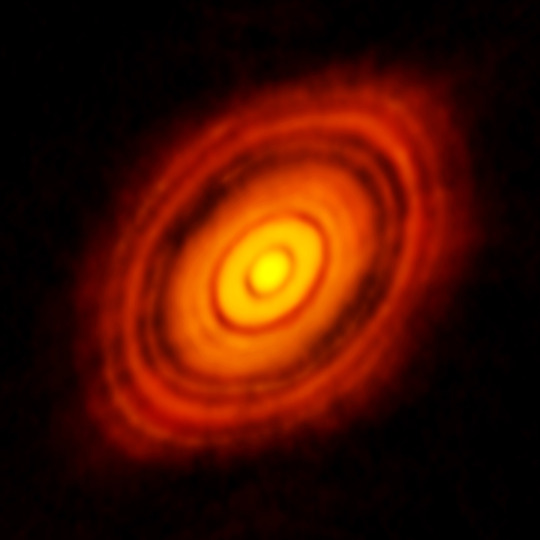
That dust globs together into larger and larger pieces, and eventually forms hundreds of "planetesimals", which are rocky bodies about a kilometer across. Planetesimals had very erratic orbits compared to the modern planets - the dust of the protoplanetary disk caused friction and drag, which threw them off course.
They frequently collided with each other, and either broke apart or stuck together and grew even larger. Arrokoth is actually a leftover planetesimal, a time capsule from the early solar system, and we were able to visit it wayyy out in the Kuiper belt with the New Horizons probe!
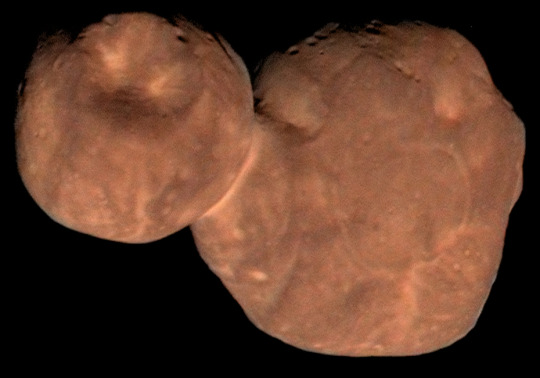
Once planetesimals get to be about the size of the moon, we call them "protoplanets". Protoplanets were fundamentally different from their planetesimal siblings - we believe they were differentiated. When an object in space gets big enough, a combination of radioactive decay, impacts, and gravitational pressure causes them to heat up and melt. Denser materials like iron and nickel sink towards their centers, while the lighter materials rise to the surface. The differentiation process is why Earth's core is made of iron, while the surface is primarily rock.
While protoplanet orbits were much more stable than those of planetesimals, they still eventually collided with each other until everything settled into the planets we see today (though gas giants had a few extra steps - that's a different post!).
We think the Psyche asteroid was a protoplanet, well on its way to becoming a bona fide planet, when an impact struck it hard enough to strip away its rocky layers, leaving behind the dense, metallic core - like in this illustration.
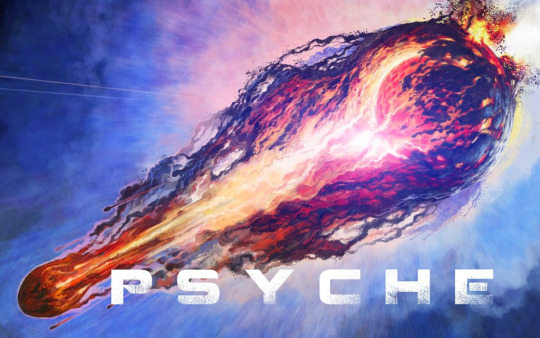
More and more, we think the properties of a planet's core are fundamental to its long-term evolution. Venus, Earth, and Mars are all roughly the same size and roughly the same distance from the sun, cosmically speaking, yet they're so different! Venus has hell death clouds, Earth is home, and Mars is dry and dead - why?
The Psyche asteroid gives us the unique opportunity to actually observe a planetary core directly - it's much harder to dig to the center of a planet than it is to go to space, so that's exactly what we're going to do!
On Thursday October 12th at 10:16am Eastern, the Psyche spacecraft will launch and begin its journey to the asteroid belt! You can watch at https://www.nasa.gov/nasatv/!

I've been a part of this mission for over four years now, and I can't speak highly enough of the team that made it happen through all of the ups and downs. Good luck out there, buddy. We're all rooting for you :')
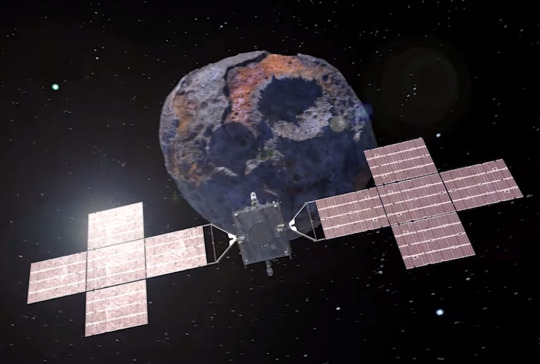
#space#NASA#psyche#asteroid#planet#psyche mission#long post#get home safe friend#you're gonna see some amazing things#For real y'all this mission has been my every single day for the past four years#I grew up with this project#end of an era but beginning of something new!#spost
380 notes
·
View notes
Text
the opposite of supershuskahkuiper is normiescoresamuraijackmacuh
the opposite of wholesome is partall
#i feel like i may have done too many jumps in logic in this reanalysis#supers: word for superheroes in the incredibles - couldnt find anything for if non supers are named in canon but normies works?#a husk is the shell of a nut - the rest of the nut is the core#ahku is almost aku the bad guy in samurai jack#(as far as i could tell patricia did oort cloud - kuiper belt so i think a slight change of spelling can be allowed)#ip address - mac address#er is the British spelling of the American uh
326 notes
·
View notes
Text
ARE THERE ANY OTHER DWARF PLANETS IN OUR SOLAR SYSTEM??"
Blog#404
Saturday, May 25th, 2024.
Welcome back,
Our Solar System is filled with diverse and wondrous worlds. From asteroids to gas giants, we’ve sent spacecraft to objects of all shapes and sizes, yet there is still much more to explore.
Among the menagerie of worlds orbiting our Sun are dwarf planets. According to the International Astronomical Union, a dwarf planet is round and circles the Sun like a planet, but has not “cleared the neighborhood” around its orbit. In other words, planets are much more massive than anything orbiting near them, while dwarf planets are not.
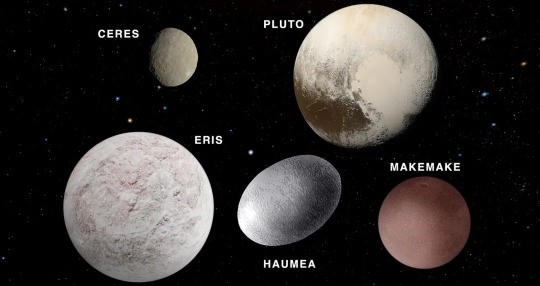
This definition, which famously removed planethood status from Pluto in 2006, disqualifies known objects in the main asteroid belt and the Kuiper Belt beyond Neptune from being named as planets.
The IAU currently recognizes five dwarf planets: Ceres, Pluto, Haumea, Makemake, and Eris. Ceres lies in the main asteroid belt between Mars and Jupiter, while the rest are in the Kuiper Belt.
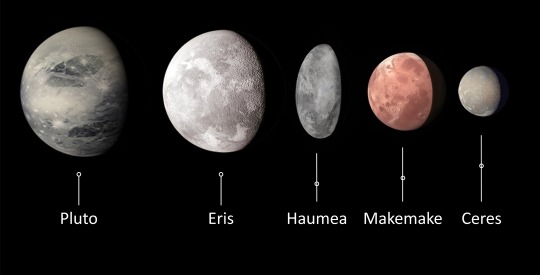
There are almost certainly more dwarf planets. Unfortunately, most are very far away, and we can’t definitively prove that they are round. Mike Brown, the Caltech astronomer who led teams of scientists that discovered Eris and other distant worlds, maintains a list of candidate dwarf planets ranked from “near certainty” to “probably not.”
Let’s visit the Solar System’s five official dwarf planets, starting from the one closest to the Sun and journeying outward.
Ceres

Ceres is the only IAU-recognized dwarf planet that resides in the main asteroid belt. With a width of about 952 kilometers (592 miles), it is the most diminutive dwarf planet — more than 13 times smaller than Earth. Yet it is by far the largest asteroid, accounting for roughly a third of the mass in the asteroid belt.
Ceres probably has a solid core and icy mantle, on top of which lies a rocky, dusty crust. It may be made of 25 percent ice by mass, making it an attractive water source for humans in science fiction.

The dwarf planet’s surface is speckled with bright salt deposits that may be remnants of briny water leaking to the surface. The source of that water, and how it ended up on the surface, is a topic of ongoing debate. Data from NASA’s Dawn spacecraft, which explored Ceres from 2015 to 2018, suggests a complex scenario where Ceres may contain deep water reservoirs connected to shallow, melted water pockets created by asteroid impacts.

One clue to Ceres’ watery origins is that it could be a protoplanet that formed elsewhere before migrating into the asteroid belt, where Jupiter’s gravity kept any large worlds from forming.
Ceres gets its name from the Roman goddess of agriculture. According to NASA, the word cereal has the same origin.
Pluto

Pluto was our ninth planet until 2006. It is virtually tied with Eris for the largest-sized dwarf planet, with a diameter of about 2,380 kilometers (1,400 miles) — roughly two-thirds the size of Earth’s Moon.
Discovered in 1930, Pluto went unexplored until NASA’s New Horizons spacecraft flew past the icy world in 2015, revealing surprisingly youthful mountains, a pale “heart” of frozen nitrogen, and red patches of complex molecules called tholins.

Pluto may have once had a subsurface ocean. Whether or not it still holds water beneath its surface is less clear, but there’s a chance such an ocean could be habitable, challenging our expectations on where to find life in our Solar System.
After New Horizons completed its Pluto flyby and crossed into the dwarf planet’s shadow, it captured a magnificent halo of blue haze. The haze may be created by atmospheric processes similar to those above Titan.

Pluto is named after the Roman god of the underworld. Its five moons Charon, Styx, Nix, Kerberos, and Hydra have underworld-themed names and circle the dwarf planet in neatly nested orbits. They were likely formed long ago when another object smashed into Pluto, creating debris that coalesced into moons.
Haumea

Haumea may be a dwarf planet, but it boasts rings and moons just like its beefier planetary counterparts. The rings were discovered in 2017 when astronomers watched Haumea pass in front of a star, revealing dips in starlight that could only be explained by the presence of a ring system. Among the telescopes watching were two funded by The Planetary Society’s Shoemaker NEO Grant program.
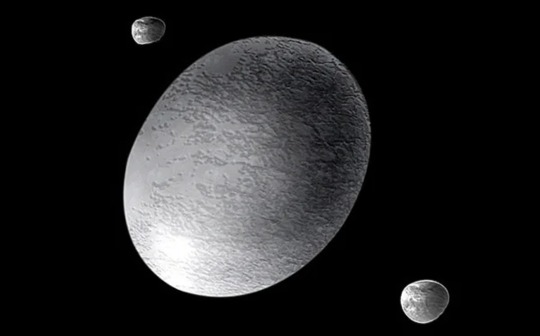
Haumea makes a full rotation in just four hours. Its high-speed spin distorts the dwarf planet’s shape, giving it an egg-like appearance. It measures roughly 2,322 kilometers (1,442 miles) across its longest axis. Another object may have slammed into Haumea in the past, giving it its fast rotation rate.
Haumea is named after the Hawaiian goddess of fertility. Its two moons, Namaka and Hi'iaka, are named after Haumea’s mythological daughters.
Originally published on www.planetary.org
COMING UP!!
(Wednesday, May 29th, 2024)
"ARE THERE ANY OTHER DWARF PLANETS IN OUR SOLAR SYSTEM?? PT.2"
#astronomy#outer space#alternate universe#astrophysics#universe#spacecraft#white universe#space#parallel universe#astrophotography#dwarf planet#pluto
38 notes
·
View notes
Text
When NASA released images of Pluto in 2015 taken by the New Horizons spacecraft, many were captivated by the dwarf planet’s heart-shaped feature, now called Tombaugh Regio. And now the mystery of how this “heart,” which is nearly 1,000 miles (1,600 kilometers) across, came to be may be solved. A recent study in Nature Astronomy reveals how the western half of the heart, known as Sputnik Planitia, is the result of a massive impact. Based on simulations, the team suggests a planetary body roughly the size of Arizona from north to south collided with Pluto at a slow speed, creating the tear-shaped area.
“The formation of Sputnik Planitia provides a critical window into the earliest periods of Pluto’s history,” said study co-author Adeene Denton, a planetary scientist at the University of Arizona, in a press release. “By expanding our investigation to include more unusual formation scenarios, we’ve learned some totally new possibilities for Pluto’s evolution, which could apply to other Kuiper Belt objects as well.”
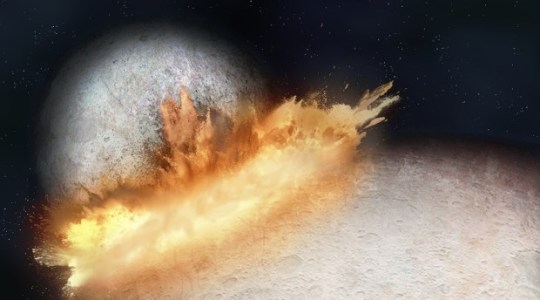
Deciphering the past
Sputnik Planitia consists of glacial plains of nitrogen ice. It is lower in elevation than the rest of the dwarf planet by 2.5 miles (4 km).
The team used computer simulations to model the impact on Pluto. The simulations confirmed that instead of a head-on collision, the impact hit at an oblique angle to create the shape we see today. And, rather than sinking into the world as might be expected, the impactor’s remains stayed littered on the surface. “Pluto’s core is so cold that the rocks remained very hard and did not melt despite the heat of the impact, and thanks to the angle of impact and the low velocity, the core of the impactor did not sink into Pluto’s core but remained intact as a splat on it,” said Harry Ballantyne, an astrophysicist at the University of Bern and the study’s lead author.
Furthermore, the simulations suggested that Pluto may not have the substantial subsurface ocean that has been proposed for the tiny world. This ocean has been suggested in part to explain why Tombaugh Regio is near the equator, rather than the pole, as would be expected after time. That’s because a depression with less mass than the surrounding area, such as the heart, should have moved toward the body’s pole. An ocean just beneath the surface, however, would bulge up under the thinner ice of Tombaugh Regio, lending it heft and keeping it near the equator.
Instead, the team found that much of the impactor’s mass could have sunk into Pluto’s core, giving the area enough mass to stay put without the need for a subsurface ocean, or at least a substantial one. “This novel and inventive origin for Pluto’s heart-shaped feature may lead to a better understanding of Pluto’s origin,” said Denton.
18 notes
·
View notes
Note
how would you describe neptune and krypton's dynamic with the two planets that where born from uranus and oceanus' deaths?
Neptune doesn't interact with either of them. He has an out of sight, out of mind kind of mentality, since he decided to stay near the Kuiper Belt with the other dwarf planets. He's a bit more sane here because he has company that isn't separated by rock, and because of his lessened paranoia he let Triton pass with no problems. Triton still visits him from time to time when he remembers that one Giant who looks like he's about to cry. Neptune doesn't interact with the Giants anymore, and when Aether approaches him he avoids him further.
(Krypton is dead. Someone must have forced his core to overheat.)
7 notes
·
View notes
Text

siebren de kuiper 'sigma' x reader
gn!reader. fluff. angst. talks about sigmas lore. overwatch lore in general. uses (name), no y/n really. established relationship. reader is older. no younger than 50. reader is a overwatch agent. sigma and reader are married. moira hate but not too much. uses of dutch pls tell me if the translations are wrong :). no pronouns. all in second person.
color coded text: sigma, you

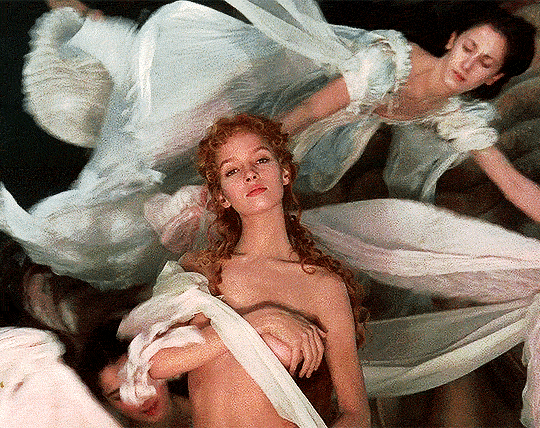

general headcannons
*you are a support character, a nanobologist and scientist that helped create various weapons of the original overwatch team ( mercy's staff, your own sniper as well as ana's)
you were married to sigma way before overwatch began. you always were happy to indulge in his many theories about gravity and you've even helped him try to create a few gadgets to harness it.
though it never worked but he was always grateful that you even listened to his incoherent ramblings when no one else would.
you're a native english speaker but you learned dutch to communicate with sibren more not only to understand him when he switches from english to dutch mid science experiment but to make him feel more comfortable around you at home.
sibren likes to calls you cute nicknames like poesje, darling, mijn geliefde, sweetheart and Mijn lieverd.
translation: kitty, my lover and my darling
you begged seibren not to go to space when the offer came, saying that you feel like something bad would happen but he promised you he's be fine. kissing your hand and rubbing your back when you would try to object.
you made him promise you that he'd come back and he did.. i suppose he didn't lie
when seibren went to space to further his studies you went back into yours trying your best to distract yourself from your husband.
you worked on your inventions─making deployable mist, guns thats can heal, turrets that can make you go faster, you worked yourself to the bone doing anything to distract yourself from the thought of him.
when you found out about sibrens accident you were understandably shaken to the core. you didn't move or eat for days. instead you watched the several tapes of footage from you twos wedding.
you remembered the phone-call, a woman told you thats he was dead and his bodies whereabouts was classified it shattered your heart.
you moved into your laboratory the day after, deciding looking at sketches was better than the pictures of you and your dead husband on the walls
when you got winston's recall you were a mess, eyes dull and heart forever heavy you felt torn. on one side you wanted to wallow in your on despair and not answer, on the other there was a small voice saying 'sibren wouldn't want this for you'
after going back and forth in your mind and the continuous beeping of the message from your computer you answered it.
'in game' headcannons
your older overwatch friends are so worried about you in ow1, you have many voice lines thats are pretty much saying "you don't look so good, i hope you feel better one day"
you also have at least 2 of voicelines that pretty much say you wish you could go back and stop that day (sibren leaving) from happening
when sibren or sigma got released your voicelines for him seemed very, emotional to say the least.
(you): what have they done to you my liefde?
sigma: something i wish didn't have to be
(you): what have they done to you my liefde?
sigma: it is i whose to blame...
translation: liefde = love
i belive he blames himself for a lot of what happened with the exposure to the black whole and even the talon thing but i also believe that he isn't exactly sorry about what happened either because it furthered his life long research
you're the only person that makes him say/think anything close 'talon bad' instead of projecting or changing the subject. he's still being manipulated and it's hard to snap someone out of that mindset but he's really trying for you
(you): sibren those people... they're using you
sigma: they're helping me further my research.....i think
(you): it's always what you think and never what you know
(you): sibren those people... they're using you
sigma: i think they're aiding me in my studies...
(you): it's always what you think and never what you know
sigma really wants to believe talon is helping him and not using him but he also strongly believes you're the smarted person he knows so when you say that talon is bad it dose bring out his second judgment
you two have skin specific voice lines depending on what he's wearing when he wears his asylum and subject sigma and you eliminate him you say things like "mijn arme hondje" and "i hope you understand..."
translation: mijn arme hondje = my poor dog/puppy
when he wears skins like maestro sigma he flirts a bit more when you get an elim on his team he says "music to my ears!" and "je bent een prachtige symfonie". when he kills you he says things like "mijn symfonie..." and "jouw hartslag was mijn favoriete liedje..."
translation: je bent een prachtige symfonie = you're a beautiful symphony
translation: mijn symfonie = my symphony
translation: jouw hartslag was mijn favoriete liedje= you're heart beat was my favorite song
one universal voice line you always have when you eliminate him regardless of the skin is "i'm sorry my love"
you don't have alot of interactions with other talon members but it rangers from kindess/neutrality (sombra and baptiste, gabriel, widowmaker) to hate (moira, doomfist)
your voice lines with moira are very hateful solely for the fact the almost mocks you about what she did to sigma whenever shes on a team with you
moira: still mourning his changes?
(you): keep pestering me and i'll resort to conducting experiments of my own.
moira: *laughs* i'd like to see you try
moira: still mourning over his changes?
(you): i will make you experience more pain than he has
moira: *laughs* i'd like to see you try
in overwatch 2 your voices lines with sigma are a little bit more happier but they still teeter the line of angst because sigma's mind isn't all there
sigma: my love are we still going to lunch after the seminar?
(you): that was years ago schatje
translation: schatje = baby
your archive events dont necessarily surround him but they do play a big role in your character growth. like when you got a scientist skin theres always references to him no matter if its your voice lines or the description of the skin
speaking of events! when he got his imperial mythic you got a skin where you were his 'monarch' and had a matching skins where you wore a crown as well!
the voice lines you and him got were similar to him and mercys but your had more of a flirtatious undertone.
sigma: speak to me monarch, what do you see in our future.
(you): us ruling side by side, your excellency.
you always wear your wedding bsnd in every skin you have (even in overwatch 1 before he was announced!) and he has several skins where his is around his neck as a necklace!
#overwatch x reader#ow2 x reader#overwatch fanfiction#sigma x reader#siebren de kuiper x reader#overwatch x you#📓💭🪷
87 notes
·
View notes
Text
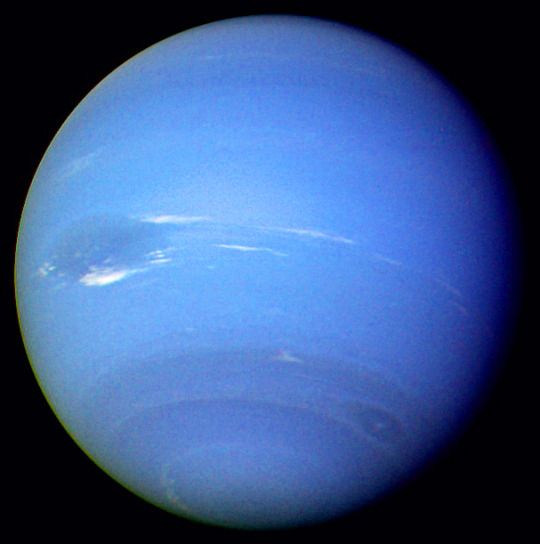
Many people will be familiar with Neptune through a picture like this one (JPL). But over the past few days, a 2023 paper by Patrick Irwin et al. (doi) has been making the rounds because it reminds us that the deep saturation of these pictures does not correspond to Neptune's "true-colour" appearance. Their processing of the data from Voyager 2—the only probe to visit either of the "icy giants", Uranus and Neptune, and the second probe to cross the heliosheath—with the aim of preserving true-colour reveals a more subdued hue:

This puts Neptune closer to Uranus in the visual spectrum. Still, its surface remains bluer and less uniform; observe the "Great Dark Spot" above, a storm half as tall as the Earth and approximately as wide. This storm disappeared in the years after Voyager 2 passed the planet, but it was not the last.
Neptunian climatology is in fact something of an extreme science: the winds of its methane-dominated atmosphere regularly reach in excess of 2000km/h, the fastest found in the Solar System. Like Uranus, it's also thought possible that the high pressures near its (probably rocky) core decompose atmospheric methane and compress it into diamond crystals. In other words, at depths of 7000+ kilometers, it may "rain diamonds".
Neptune's biggest moon, Triton, is unique among large moons in having a retrograde orbit—that is, it moves opposite Neptune's own rotation. This suggests that it didn't form from the same region of the Sun's protoplanetary disk as Neptune, but is in fact a captured dwarf planet that may have originated further out in the Kuiper Belt. While our own Moon's orbit grows wider with time, tidal effects are decaying Triton's orbit, and in some three and a half billion years it may cross the Roche limit and be broken apart by Neptune's gravity. For an astronomically brief time, Neptune will have spectacular rings just as Saturn does now.
#space#text#neptune#space series#<guess i'm doing this now bc most of the space accounts here besides apod annoy me
19 notes
·
View notes
Text
☆゚.*・。゚Space ☆゚.*・。゚
Space is so much more than our solar system, far more interesting than where we lay. Beyond the Kuiper belt lays many mysteries and beautiful stars, planets, nebulae, and so many more sights we cannot see with the bare eye.
Many people think of aliens as such a fantasy and unrealistic. If you think about it from an open perspective, it sounds maintain. In the Kepler belt lies a dwarf planet known as “Ceres” this dwarf planet used to be a roman sea planet. It being a roman sea planet leads many astrobiologists and astronomers to believe that the dwarf planet used to have fish before earth did.
Following up on the thought about alien creatures, Earth isn’t the only planet humans can survive on. There are many other planets known as “Super-Earths” which have very similar characteristics as Earth, but have small differences. Kapteyn B, for example, is a Super-Earth 12 light years away from earth. The temperatures are extremely similar to Earth, gravitys very similar, and it’s a great length away from the star as well as it’s tidally locked. Kapteyn B’s star, Kapteyn, is 3000 K, which is remotely colder than the Sun, yet Kapteyn B is close to Kapteyn. This leaves the temperature of Kapteyn B to be around 80-150 degrees, which is extremely hot for Earth; yet at livable conditions. Astrobiologists and astronomers believe that there is water on this planet. Making it suitable for life.
The downside of Kapteyn B is there is no natural satellite, which is what our moon is. No natural satellite means that there is nothing producing photovoltaic cells. What photovoltaic cells do is convert sunlight into electricity. It would be harder, but we could still produce electricity. With all these qualities, it’s not so different from earth. So whats stopping natural selection from affecting these other Earth-like planets?
゚。Stars ゚。
Stars are what make the night sky so pretty, but they have more purpose than to simply look pretty. The most influential star to Earth is our sun. Our suns most obvious job is to provide warmth and UV rays for earth, but it does so much more than we would think.
Stars create a substance called “Hydrostatic Equilibrium”, which is the balance between gravity. This keeps every planet in our solar system as one piece by pulling it together with its opposite reaction of the pressure trying to blow it apart. Which keeps it together in the end.
In the center of every star the core is the hottest part. When the star is hot enough it creates “Nuclear Fusion”, nuclear fusion that keeps our atmosphere breathable, keeping out long-lived radioactive waste and greenhouse gases.
☆゚.*・。゚Light Travel ☆゚.*・。゚
Albert Einstein had once done a study on how humans will never travel the speed of light. Light is the fastest moving thing in the entire universe that we have discovered. No manmade creation will ever replicate the speed of light or even come close to.
With our disadvantage of speed we will never be able to explore and uncover the mysteries of the entire universe. Our knowledge will always remain limited of the unknown. As of 2024 the farthest the human eye can see with a telescope is 14 billion light years. Which is extremely far, but our universe will always be so much further.
Us as humans will likely never leave our solar system. With our current space travel it would take us thousands of years to travel a single light year, the closest solar system to ours is approximately 4 light years.
☆゚.*・。゚Why going to Mars isn’t a great idea ☆゚.*
Mars is a huge change from Earth. Our water sources would only come from ice and water from under the surface, which would take a lot of time to get the one body of water to the entire planet. Which would be exhausting and the water wouldn’t last long of a planet of 8 billion people.
Mars is significantly smaller than Earth, which decreases the planets eightfold and making the gravity much lighter than Earth’s. This would make us have to change our entire scaling system across the entire world for our health benefit. Gravity isn’t the only problem, Earth struggles with overpopulation as it is. If everyone from Earth move to Mar’s it would be extremely crowded and overpopulated.
Resources would be scarce and we would have to rely on Earth. Mars doesn’t have any animals, meat would end up being a luxury because all the animals would be brought up from Earth. If we have to rely on Earth and continuously having to make trips back and forth it would end up being extremely expensive.
We would have to set our government up again. People would have to come to a mutual agreement on if we should keep or change our ways from what they were on earth. Either way, what we do would end up becoming a constant war for who owns what land and what land belongs to what country.
We would have to start over completely and start plantations and all sorts of farms. Starting farms on Mars though would be tricky because of all the toxic elements in the soil that would get into our food that we would end up digesting. Which could slowly lead to us being poisoned.
゚.*・。゚Fun facts about my favorite planet
An exoplanet called LHS 1140 B orbits around a G-type star and is bigger than earth, people do say that with the atmosphere of the planet, the planet could very much support the existence of water. One day in 2017 they found oxygen molecules surronding the planet. Which is a good sign because then you know well oxygen on the planet can be breathed in safely. The planet is 140+ light years away, making it absolutely impossible to ever colonize.
8 notes
·
View notes
Note
Hi there! I am super excited for the next chapter, I honestly admire how much you guys release be it art or writing! I just had a discussion with a friend and it funnily led to your au. I don‘t know if you guys clarified why Leo was given the name Tyche, but I assumed it was in respect to the Greek goddess Tyche and a lot of sarcasm and foreshadowing since her name means luck and she is the governor of fortune and prosperity (which I thought you intentionally gave him the name in respect to Leo governing his brothers‘ prosperity)
But that friend of mine and I just discussed a bit about Planet Nine, a theoretical giant planet in our solar system which is yet to be found and we only know of its (theoretical) existence due to irregularities in movements within the Kuiper Belt. Scientists are calling it Planet Nine for now but consider the name Tyche for when they hopefully find it
And I gotta wonder, was that intentional??
Thank you for reading!
Ahhhh hello! Thank YOU for reading the fic and checking out our work!
So we didn't clarify bc we wanted people to kinda come to their own conclusions on his given champion name! There are many interpretations that can be taken as to why he was given that name, but at its core, you are pretty much spot on. The Goddess of Fortune and Prosperity, and yet his role in the Nexus is to be a harbinger of death and destruction, in many ways. It's irony. It's sarcastic. It's also true in ways that are yet to be revealed.
Also the Planet Nine theory is so fun, I think that would be a sick name for it! I actually did not know this and there have been several other things that have fallen into place accidentally as we've plotted and planned which has left us all giggling with absolute GLEE.
Can't wait to keep sharing the story as it grows and expands and gets more and more fleshed out over time!
~ Starr
13 notes
·
View notes
Text
Desertduo oneshot for Kuiper-BeltAU. Just some fluff. And a small tiny introduction to nothing and something.
---------
Imagine a realm where vast shards of crystalline ice drift in a swirling cosmic ballet. These shards, gleaming with a spectral luminescence, are inhabited by beings of myth and wonder. Ethereal creatures, born of starlight and the primordial essence of creation, call the Kuiper Belt their home. They flit and soar through the void, their forms as transient as the constellations above.
The crystalized nothingness was their only home, nowhere else to go, because their home stretched for millions of miles, it was never ending, as if they owned it all, and nothing at the same time.
A gentle hand reached out to poke at the crystalline shard, the nail barely scratching over the top layer, making it slightly move away with a glass like sound. The disturbance made it shimmer in the light that seemed to come out from every angle of the Universe.
The small crystal was pulled back in, the gravity not letting it go nowhere far, at least for now, for now it was trapped, like all of them.
They weren't trapped tho, they were home, at least that is what Scar thought. He seemed to feel content with staying where he was, unlike the rest.
They seemed urgent to find a way, to discover ways of being a part of society that didn't know of them anyways. Had he not provided enough?
The more he thought about it, the more sour feeling overtook his mind. The silence that hung in the atmosphere only worsened his rage, biting down on his lip, in a swift movement pulling the floating space dust in his orbit, creating a new gas planet in his hands.
That is all that it was, is that where all of them wanted to go to? A rock with life on it? It was that simple, there was nothing to see, it was just dust and air.
A slight sparkle appeared in the small crystal, the new planet was quickly crashed together in his hands, dropping the remains, leaving new asteroids in the system, someone would deal with them.
As he suspected the glistering became stronger, and so did the cold ari started to fade away, a careful, yet calm hand placed itself on his shoulder.
''For everything you worry about, I am impressed by how are you still alive.'' Grian whispered in a slightly foolish tone, stepping next to Scar and sitting down at the glassy edge of the crystalized rock.
A moment of silence lingered in the air, it never got too old to view the passing sparkles of falling meteors, it made them feel like a kid on the Earth again. Watching the raindrops drip down on the car windows and making up the most absurd games in their own head, just to entertain their bored minds.
Grian was snapped back to reality, to present, hearing a low huff of disagreement, ''Nothing I am worried about. Just tell me what is not here, that is anywhere else.''
Both of them made eye contact, Grian always felt like he was staring into nothing when looking at the others eyes, it felt like any sign of life was missing from them. And who was he to know if it wasn't true, and who was he to judge when his own eyes were just as empty on the daily, burned out from the heat.
Grian tilted his head, thin sounds of jingles from every possible jewelry on the man made a heavenly sound, like the wind chimes in a summer's day after a cold war. A weak smile appeared on the Sun's face, feathers slightly shifting, ''Difference. They aren't seeking for anything but difference, Scar. Let them have it, they will be back in no time,'' he grabbed Scars hand, and with the help of his own, made a motion their way with it to get the broken pieces of the newly formed, and broken planet, back, ''it will take only so much time before they realize that a humans body can only handle so much time.''
He melted the planet back together, giving it a solid core with the heat, ''What you create and hold, is what everyone depends on, we need you more than you know, so don't expect us to ever leave.'' Grian gave Scar back the fixed planet.
Suddenly it felt dear to him, it hurt to think of breaking it. A simple dwarf planet with no one to go to, no moon to guide it, no stars to follow, no rings to travel with. It was a loner.
His loner with a core. With a swipe of his hand, in silence he named it CFBDSIR 2149-0403.
Before he could place it anywhere, a small ''Learn to let go. Just for a moment.'' singed in his ear.
Scar looked back at Grian, ''I don't think I can.'' He felt like cracking, had he really gotten attached to something he had no time put in?
''It will come back eventually, let it float away, it will find it's way back to you when it is ready to.'' Grian calmly opened Scars fingers and freed the small ball of it's future ahead of itself.
Both of them looked as it floated away amongst everything else, crystals casting a cold reflection on it, it looked blue, it was a cold rouge.
Somewhere out in the forever lasting nothingness, a soul felt a pull towards the rouge, both lonely things, yearning for a connection. A bright white humanoid figure formed out of a ball of white void.
A glowing dust hand reached out far, far away for something that was so close, yet forever away. The soul cried out to it.
Home is where a core lays, life is formed where it seeks it.
19 notes
·
View notes
Text
oc/au thing blast ! !

bonus shit undercut
A towering, seemingly intimidating and a soft spoken individual, May Bells is the beating heart of a mythical forest away from the rest of the world. She seldom speaks, and this is easily misinterpreted as her being “uncaring”, “aloof”, and “mysterious”. However, his true personality is quite the opposite. They’re sensitive, gentle, compassionate- and cries very easily. May longs for a deep connection with another person, but her awkwardness makes this difficult. She can be very airheaded while daydreaming for the person of her dreams, albeit if it’s a friend or lover.
Kuiper fairy+ parasol thing they carry


While he absolutely has no interest in fighting, her main weapon is some sort of heavy poison, targeting the core of robot masters to cause them to break down. Even a finger tip’s size dose is enough for them to neutralize any opponents. May Bells hates having this ability however, because he believes it urges others to stay away from her.
In their free time, May likes to daydream (although she keeps that a secret), decorate, and sow, because where else can you make festive clothes and decor in a forest? It’s a fun little activity for him and her kuiperdroid-like fairies.
May has a passion for all things that are cute, to animals, stuffed animals, bugs, and pretty plants. She even names them things like “sweet little one.” May is horrified at the thought of hurting anything cute, and feels terrible whenever she accidentally steps on something. He’s also a vegetarian- because the thought of eating an animal brings them horror.
Enjoy this au character, sadly proper development is being stalled due to school and general fatigue
ty for reading, have a video of a funny little guy
12 notes
·
View notes